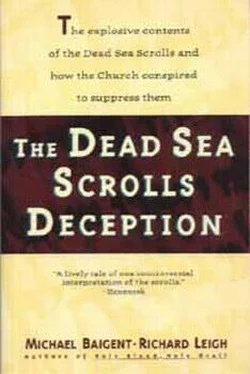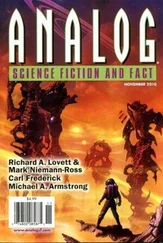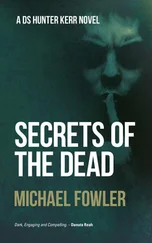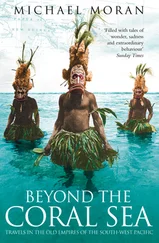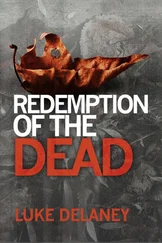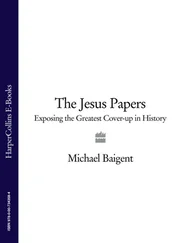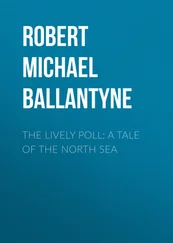If the oil is indeed balsam oil, it may well be part of the treasure stipulated in the ‘Copper Scroll’. In any case, it is an incongruously costly commodity to have been used by a community of supposedly isolated ascetics in the desert. As we have noted, however, one of the most important features of the ‘Copper Scroll’ is that it shows Qumran not to have been so isolated after all. On the contrary, it would seem to establish links between the Qumran community and factions associated with the Temple in Jerusalem.
Found in Cave 1 at Qumran, the ‘Community Rule’, as we have seen, adumbrates the rituals and regulations governing life in the desert community. It establishes a hierarchy of authority for the community. It lays down instructions for the ‘Master’ of the community and for the various officers subordinate to him. It also specifies the principles of behaviour and the punishment for violation of these principles. Thus, for instance, ‘Whoever has deliberately lied shall do penance for six months.’ 2The text opens by enunciating the basis on which the community define and distinguish themselves. All members must enter into a ‘Covenant before God to obey all His commandments’; 3and he who practises such obedience will be ‘cleansed from all his sins’. 4Adherence to the Law is accorded a paramount position. Among the various terms by which the community’s members are designated, one finds ‘Keepers of the Covenant’ 5and those who have ‘zeal for the Law’. 6
Among the rituals stipulated, there is cleansing and purification by baptism — not just once, but, apparently, every day. Daily prayers are also specified, at dawn and at sunset, involving recitations of the Law. And there is a ritually purified ‘Meal of the Congregation’ 7 — a meal very similar, as other scrolls attest, to the ‘Last Supper’ of the so-called ‘early Church’.
The ‘Community Rule’ speaks, too, of the ‘Council’ of the Community, made up of twelve men and, possibly, a further three priests. We have already discussed the interesting echoes of the ‘cornerstone’ or ‘keystone’ image in relation to the Council of the Community. But the scroll also states that the Council ‘shall preserve the faith in the Land with steadfastness and meekness and shall atone for sin by the practice of justice and by suffering the sorrows of affliction’. 8
In their eagerness to distance the Qumran community from Jesus and his entourage, scholars promoting the consensus of the international team stress that the concept of atonement does not figure in Qumran teachings — that Jesus is to be distinguished from Qumran’s ‘Teacher of Righteousness’ in large part by virtue of his doctrine of atonement. The ‘Community Rule’, however, demonstrates that atonement figured as prominently in Qumran as it did with Jesus and his followers in the so-called ‘early Church’.
Finally, the ‘Community Rule’ introduces the Messiah — or perhaps Messiahs, in the plural. Members of the Community, ‘walking in the way of perfection’, are obliged to adhere zealously to the Law ‘until there shall come the prophet and the Messiahs of Aaron and Israel’. 9This reference is usually interpreted as meaning two distinct Messiahs, two equally regal figures, one descended from the line of Aaron, one from the established line of Israel — i.e. the line of David and Solomon. But the reference may also be to a dynasty of single Messiahs descended from, and uniting, both lines. In the context of the time, of course, ‘Messiah’ does not signify what it later comes to signify in Christian tradition. It simply means ‘the Anointed One’, which denotes consecration by oil. In Israelite tradition, it would seem, both kings and priests — in fact, any claimant to high office — were anointed, and hence Messiahs.
Copies of the ‘War Scroll’ were found in Caves 1 and 4 at Qumran. On one level, the ‘War Scroll’ is a very specific manual of strategy and tactics, obviously intended for specific circumstances, at a specific place and time. Thus, for example: ‘Seven troops of horsemen shall also station themselves to right and to left of the formation; their troops shall stand on this side…’ 10On another level, however, the text constitutes exhortation and prophetic propaganda, intended to galvanise morale against the invading foe, the ‘Kittim’, or Romans. The supreme leader of Israel against the ‘Kittim’ is called, quite unequivocally, the ‘Messiah’ — though certain commentators have sought to disguise or dissemble this nomenclature by referring to him as ‘Thine anointed’. 11The advent of the ‘Messiah’ is stated as having been prophesied in Numbers 24:17, where it is said that ‘a star from Jacob takes the leadership, a sceptre arises from Israel’. The ‘Star’ thus becomes a sobriquet for the ‘Messiah’, the regal warrior priest-king who will lead the forces of Israel to triumph. As Robert Eisenman has stressed, this prophecy linking the Messiah figure with the image of the star occurs elsewhere in the Qumran literature, and is of crucial importance. It is also significant that the same prophecy is cited by sources quite independent of both Qumran and the New Testament — by historians and chroniclers of 1st-century Rome, for example, such as Josephus, Tacitus and Suetonius. And Simeon bar Kochba, instigator of the second revolt against the Romans between ad 132 and 135, called himself the ‘Son of the Star’.
The ‘War Scroll’ imparts a metaphysical and theological dimension to the struggle against the ‘Kittim’ by depicting it as a clash between the ‘Sons of Light’ and the ‘Sons of Darkness’. More importantly still, however, the scroll contains a vital clue to its own dating and chronology. When speaking of the ‘Kittim’, the text refers quite explicitly to their ‘king’. The ‘Kittim’ concerned cannot, therefore, be the soldiers of republican Rome, who invaded Palestine in 63 BC and who had no monarch. On the contrary, they would have to be the soldiers of imperial Rome, who invaded in the wake of the revolt of ad 66 — although, of course, occupying troops had been present in Palestine since the imposition of imperial Roman prefects or procurators in AD 6. It is thus clear that the ‘War Scroll’ must be seen in the context not of pre-Christian times, but of the 1st century. As we shall see, this internal evidence of chronology — which advocates of the ‘consensus’ contrive to ignore — will be even more persuasively developed in one of the other, and most crucial, of the Qumran texts, the ‘Commentary on Habakkuk’.
The ‘Temple Scroll’ is believed to have been found in Cave 11 at Qumran, though this has never been definitively established. As its name suggests, the scroll deals, at least in part, with the Temple of Jerusalem, with the design, furnishings, fixtures and fittings of the structure. It also outlines specific details of rituals practised in the Temple. At the same time, however, the name conferred on the scroll, by Yigael Yadin, is somewhat misleading.
In effect, the ‘Temple Scroll’ is a species of Torah, or Book of the Law — a kind of alternative Torah used by the Qumran community and other factions elsewhere in Palestine. The ‘official’ Torah of Judaism comprises the first five books of the Old Testament — Genesis, Exodus, Leviticus, Numbers and Deuteronomy. These are deemed to be the books of laws which Moses received on Mount Sinai, and their authorship is traditionally ascribed to Moses himself. The ‘Temple Scroll’ constitutes, in a sense, a sixth Book of the Law.
The laws it contains are not confined to rites of worship and observance in the Temple. There are also laws pertaining to more general matters, such as ritual purification, marriage and sexual practices. Most important and interesting of all, there are laws governing the institution of kingship in Israel — the character, comportment, behaviour and obligations of the king. The king, for example, is strictly forbidden to be a foreigner. He is forbidden to have more than one wife. And like all other Jews, he is forbidden to marry his sister, his aunt, his brother’s wife or his niece. 12
Читать дальше
